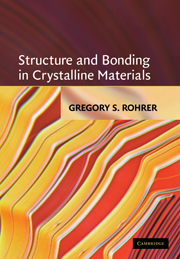Book contents
- Frontmatter
- Contents
- Preface
- 1 Introduction
- 2 Basic Structural Concepts
- 3 Symmetry in Crystal Structures
- 4 Crystal Structures
- 5 Diffraction
- 6 Secondary Bonding
- 7 Ionic Bonding
- 8 Metallic Bonding
- 9 Covalent Bonding
- 10 Models for Predicting Phase Stability and Structure
- Appendix 1A Crystal and univalent radii
- Appendix 2A Computing distances using the metric tensor
- Appendix 2B Computing unit cell volumes
- Appendix 2C Computing interplanar spacings
- Appendix 3A The 230 space groups
- Appendix 3B Selected crystal structure data
- Appendix 5A Introduction to Fourier series
- Appendix 5B Coefficients for atomic scattering factors
- Appendix 7A Evaluation of the Madelung constant
- Appendix 7B Ionic radii for halides and chalcogenides
- Appendix 7C Pauling electronegativities
- Appendix 9A Cohesive energies and band gap data
- Appendix 9B Atomic orbitals and the electronic structure of the atom
- Index
10 - Models for Predicting Phase Stability and Structure
Published online by Cambridge University Press: 23 February 2011
- Frontmatter
- Contents
- Preface
- 1 Introduction
- 2 Basic Structural Concepts
- 3 Symmetry in Crystal Structures
- 4 Crystal Structures
- 5 Diffraction
- 6 Secondary Bonding
- 7 Ionic Bonding
- 8 Metallic Bonding
- 9 Covalent Bonding
- 10 Models for Predicting Phase Stability and Structure
- Appendix 1A Crystal and univalent radii
- Appendix 2A Computing distances using the metric tensor
- Appendix 2B Computing unit cell volumes
- Appendix 2C Computing interplanar spacings
- Appendix 3A The 230 space groups
- Appendix 3B Selected crystal structure data
- Appendix 5A Introduction to Fourier series
- Appendix 5B Coefficients for atomic scattering factors
- Appendix 7A Evaluation of the Madelung constant
- Appendix 7B Ionic radii for halides and chalcogenides
- Appendix 7C Pauling electronegativities
- Appendix 9A Cohesive energies and band gap data
- Appendix 9B Atomic orbitals and the electronic structure of the atom
- Index
Summary
Introduction
We began Chapter 1 by noting that the central, fundamental question that motivates continued materials research is, how can elements be combined to produce a solid with specified properties? Previously, we divided this problem into three separate issues that we restate here to provide appropriate context for the final chapter. First, when any given elements are combined under some controlled conditions, will they react to form a compound, will they dissolve in one another, or will they be immiscible? Second, what structure will the product of this combination have and how will it be influenced by the conditions under which the elements were combined? Third, given the product phase or phases and the structure, what are the properties of this material? In this chapter, we will discuss approaches that have been developed to predict answers to at least parts of the first two questions. For the purposes of this course, we limit our structural discussion to the atomic structure. However, we note that to fully answer these two questions, the defect structure and microstructure must also be addressed.
It was noted earlier that the quantitative physical models for bonding described in Chapters 6–9 were not able to reliably predict the equilibrium crystal structure of a compound. Despite impressive theoretical achievements and the development of more advanced models during the past few decades, phase stability, crystal structures, and the properties of solids must still be determined experimentally.
Information
- Type
- Chapter
- Information
- Structure and Bonding in Crystalline Materials , pp. 424 - 476Publisher: Cambridge University PressPrint publication year: 2001
